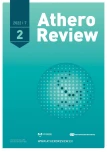Lysosomal acid lipase deficiency – differential diagnosis and treatment options in 2022
Authors:
Zuzana Urbanová 1; Věra Malinová 2; Tomáš Freiberger 4,5; Lukáš Tichý 3; Michal Vrablík 2
Authors‘ workplace:
Česká společnost pro aterosklerózu
1; Centrum preventivní kardiologie, III. interní klinika a Klinika pediatrie a dědičných poruch metabolismu 1. LF UK a VFN v Praze
2; Centrum molekulární biologie a genetiky, Interní hematologická a onkologická klinika LF MU a FN Brno
3; Centrum kardiovaskulární a transplantační chirurgie Brno
4; Ústav klinické imunologie a alergologie LF MU a FN u sv. Anny v Brně
5
Published in:
AtheroRev 2022; 7(2): 67-70
Category:
Reviews
Overview
Lysosomal acid lipase deficiency (LAL-D) is a rare autosomal recessive lysosomal storage disease caused by deleterious mutations in the LIPA gene. Occurrence is worldwide estimated to be 1 : 130 000 to 1 : 300 000 live births. Patients pre- senting in infancy have the most rapidly progressive disease, developing signs and symptoms in the first weeks of life and rarely surviving beyond 6 months of age (Wolman disease). Children and adults typically present with some combination of dyslipidemia, hepatomegaly, elevated transaminases, and microvesicular hepatosteatosis on biopsy – cholesteryl ester storage disease (CESD). Liver damage with progression to fibrosis, cirrhosis and liver failure occurs in a large proportion of patients. Elevated low-density lipoprotein cholesterol levels and decreased high-density lipoprotein cholesterol levels are common features, and cardiovascular disease may manifest as early as childhood. The lipid profile is very similar as we can see in familial hypercholesterolemia, so it is not surprising that LAL-D is under-recognized in clinical practice. This article provides practical guidance to lipidologists, on how to recognize individuals with this disease and, current management options are reviewed in light of the development of enzyme replacement therapy with sebelipase alfa, a recombinant human lysosomal acid lipase enzyme and is an update of a 2019 article with the addition of more detailed information on genetic testing options.
Keywords:
hepatomegaly – Wolman disease – cholesteryl ester storage disease – lysosomal acid lipase deficiency – dyslipidemia
Sources
1. Elleder M, Poupětová H, Ledvinová J et al. Deficit kyselé (lyzosomální) lipázy: přehled českých pacientů. Čas Lék Česk 1999; 138(23): 719–724.
2. Elleder M, Chlumska A, Hyanek J et al. Subclinical course of cholesteryl ester storage disease in an adult with hypercholesterolemia, acce-lerated atherosclerosis, and liver cancer. J Hepatol 2000; 32(3): 528–534.
3. Hulkova H, Elleder M. Distinctive histopathological features that support a diagnosis of cholesterol ester storage disease in liver biopsy specimens. Histopathology 2012; 60(7): 1107–1113. Dostupné z DOI: <http://dx.doi.org/10.1111/j.1365–2559.2011.04164.x> .
4. Wilson DP, Patni N. Lysosomal Acid Lipase Deficiency. In: Feingold KR, Anawalt B, Boyce A et al (eds). Endotext. South Dartmouth (MA): MDText. com, Inc.: 2000. Dostupné z WWW: <https://www.ncbi.nlm.nih.gov/books/NBK395569/>.
5. Reiner Ž, Guardamagna O, Nair D et al. Lysosomal acid lipase deficiency – An under-recognized cause of dyslipidaemia and liver dysfunction. Atherosclerosis 2014; 235(1): 21–30. Dostupné z DOI: <http://dx.doi.or--g/10.1016/j.atherosclerosis.2014.04.003> .
6. Fouchier SW, Defesche JC. Lysosomal acid lipase A and the hyper- cholesterolaemic phenotype. Curr Opin Lipidol 2013; 24 (4): 332–338. Dostupné z DOI: <http://dx.doi.org/10.1097/MOL.0b013e328361f6c6>.
7. Abramov A, Schorr S, Wolman M. Generalized xanthomatosis with calcified adrenals. AMA J Dis Child 1956; 91(3): 282–286. Dostupné z DOI: <http://dx.doi.org/10.1001/archpedi.1956.02060020284010>.
8. Fredrickson DS. Newly recognized disorders of cholesterol metabolism. Ann Intern Med 1963; 58(4): 718. Dostupnè z DOI:<http://dx.doi.org/10.7326/0003–4819–58–4-718_1>.
9. Grabowski GA, Du H, Charnas L. Lysosomal acid lipas e deficiencies: the Wolman disease/cholesteryl ester storage disease spectrum. In: Valle D (ed), Beaudet AL, Vogelstein B et al. The Online Metabolic and Molecular Bases of Inherited Disease. McGraw Hill 2006. Dostupné z DOI: <http://dx.doi.org/10.1036/ommbid.172>.
10. Strebinger G, Müller E, Feldman A et al. Lysosomal acid lipase deficiency - early diagnosis is the key. Hepat Med 2019; 11: 79–88. Dostupné z DOI: <http://dx.doi.org/10.2147/HMER.S201630>.
11. Valle D, Beaudet L,Vogelstein B (eds) et al. The Online Metabolic and Molecular Bases of Inherited Disease. McGraw Hill 2006. Dostupné z WWW: <https://ommbid.mhmedical.com> .
12. Chatrath H, Keilin S, Attar BM. Cholesterol ester storage disease (CESD) diagnosed in an asymptomatic adult. Dig Dis Sci 2009; 54(1): 168–173. Dostupné z DOI: <http://dx.doi.org/10.1007/s10620–008–0310–2>.
13. Malinová V, Honzík T. Lysosomální onemocnění – současné možnosti diagnostiky a terapie Pediatr Praxi 2013; 14(2): 99–103.
14. Grabowski GA, Charnas L, Du H. Lysosomal acid lipase deficiencies: the Wolman disease/cholesteryl ester storage disease spectrum. In: Valle D, Beaudet AL, Vogelstein B et al (eds). Scriver’s online metabolic and molecular bases of inherited disease. McGraw Hill: New York 2012.
15. Saito S, Ohno K, Suzuki T et al. Structural bases of Wolman disease and cholesteryl ester storage disease. Mol Genet Metab 2012; 105(2): 244–248. Dostupné z DOI: <http://dx.doi.org/10.1016/j.ymgme.2011.11.004> .
16. Burton BK, Balwani M, Feillet F et al. A Phase 3 Trial of Sebelipase Alfa in Lysosomal Acid Lipase Deficiency. N Engl J Med 2015; 373(11): 1010–1020. Dostupné z DOI: <http://dx.doi.org/10.1056/NEJMoa1501365>.
17. Pastores GM, Hughes DA. Lysosomal Acid Lipase Deficiency: Therapeutic Options. Drug Des Devel Ther 2020; 14: 591–601. Dostupné z DOI: <http:dx.doi.org/10.2147/DDDT.S149264>.
18. SPC přípravku Kanuma. Dostupné z WWW: https://www.ema.europa.eu/en/documents/product-information/kanuma-epar-product-information_cs.pdf>.
19. Bernstein DL, Hulkova H, Bialer MG et al. Cholesteryl ester storage disease: review of the findings in 135 reported patients with an underdiagnosed disease. J Hepatol 2013; 58(6): 1230–1243. Dostupné z DOI: <http://dx.doi.org/10.1016/j.jhep.2013.02.014>.
20. Urbanová Z, Malinová V. Deficit lyzosomální kyselé lipázy v diferenciální diagnostice familiární hypercholesterolemie. AtheroRev 2019; 4(1): 30–33.
Labels
Angiology Diabetology Internal medicine Cardiology General practitioner for adultsArticle was published in
Athero Review

2022 Issue 2
Most read in this issue
- Benefits of GLP-1 receptor agonists therapy for patients with cardiovascular disease
- Lysosomal acid lipase deficiency – differential diagnosis and treatment options in 2022
- How are we doing in achieving target LDL-cholesterol levels in the high-risk population in Slovakia: retrospective study
- Lifelong exposure and trajectories of the risk factors – a new direction in prediction of CVD risk
